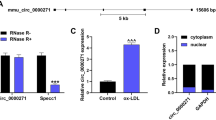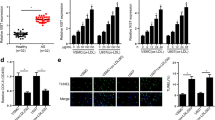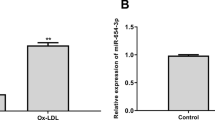Abstract
The pathophysiological mechanism of carotid atherosclerosis (CAS) involves endothelial cell dysfunction, vascular smooth muscle cells (VSMCs), and macrophage activation, which ultimately leads to fibrosis of the vessel wall. lncRNA works weightily in the formation of CAS, but the function and mechanism of lncRNA LINC01123 in stable plaque formation are still equivocal. We collected blood samples from 35 CAS patients as well as 33 healthy volunteers. VSMCs treated with oxidized low-density lipoprotein (ox-LDL) were utilized as the CAS cell models. We applied qRT-PCR for detecting LINC01123, miR-1277-5p and KLF5 mRNA expression, CCK-8 method and BrdU test for determining cell proliferation, Transwell test for measuring cell migration, as well as Western blot for assaying KLF5 protein expression. Dual-luciferase reporter experiment was adopted for assessing the interaction between LINC01123 and miR-1277-5p, as well as KLF5 and miR-1277-5p. LINC01123 and KLF5 expression were dramatically up-regulated, while miR-1277-5p expression was down-regulated in CAS patients and ox-LDL-induced CAS cell models. Overexpressed LINC01123 notedly promoted VSMCs migration and proliferation. LINC01123 knockdown repressed cell proliferation and migration. Also, LINC01123 targeted miR-1277-5p and down-regulated its expression, while miR-1277-5p could negatively regulate KLF5 expression. LINC01123 is highly expressed in CAS patients, and promotes cell proliferation and migration via regulating miR-1277-5p/KLF5 axis in ox-LDL-induced VSMCs. It might be involved in the fibrous plaque formation.






Similar content being viewed by others
Availability of data and materials
The datasets used and/or analyzed during the present study are available from the corresponding author on reasonable request.
References
Bartel DP (2004) MicroRNAs: genomics, biogenesis, mechanism, and function. Cell 116(2):281–297
Chen LL, Carmichael GG (2010) Decoding the function of nuclear long non-coding RNAs. Curr Opin Cell Biol 22(3):357–364
Cheng Q, Zhang M, Zhang M, Ning L, Chen D (2020) Long non-coding RNA LOC285194 regulates vascular smooth muscle cell apoptosis in atherosclerosis. Bioengineered 11(1):53–60
Di Gregoli K, Mohamad Anuar NN, Bianco R et al (2017) MicroRNA-181b controls atherosclerosis and aneurysms through regulation of TIMP-3 and elastin. Circ Res 120(1):49–65
Gepner AD, Young R, Delaney JA et al (2017) Comparison of carotid plaque score and coronary artery calcium score for predicting cardiovascular disease events: the multi-ethnic study of atherosclerosis. J Am Heart Assoc 6(2):e005179
Guo X, Liu Y, Zheng X, Han Y, Cheng J (2020) HOTTIP knockdown inhibits cell proliferation and migration via regulating miR-490-3p/HMGB1 axis and PI3K-AKT signaling pathway in ox-LDL-induced VSMCs. Life Sci 248:117445
Hankey GJ. Stroke (2017) Lancet 389(10069):641–654
Hansson GK, Hermansson A (2011) The immune system in atherosclerosis. Nat Immunol 12(3):204–212
Hu YW, Guo FX, Xu YJ et al (2019) Long noncoding RNA NEXN-AS1 mitigates atherosclerosis by regulating the actin-binding protein NEXN. J Clin Invest 129(3):1115–1128
Hua Q, Jin M, Mi B et al (2019) LINC01123, a c-Myc-activated long non-coding RNA, promotes proliferation and aerobic glycolysis of non-small cell lung cancer through miR-199a-5p/c-Myc axis. J Hematol Oncol 12(1):91
Jono S, McKee MD, Murry CE et al (2000) Phosphate regulation of vascular smooth muscle cell calcification. Circ Res 87(7):E10–E17
Jouni H, Askew JW, Crusan DJ, Miller TD, Gibbons RJ (2016) Temporal trends of single-photon emission computed tomography myocardial perfusion imaging in patients without prior coronary artery disease: a 22-year experience at a tertiary academic medical center. Am Heart J 176:127–133
Koritschoner NP, Bocco JL, Panzetta-Dutari GM, Dumur CI, Flury A, Patrito LC (1997) A novel human zinc finger protein that interacts with the core promoter element of a TATA box-less gene. J Biol Chem 272(14):9573–9580
Kudlaty EA, Kendrick DE, Allemang MT, Kashyap VS, Wong VL (2016) Upper extremity steal syndrome is associated with atherosclerotic burden and access configuration. Ann Vasc Surg 35:82–87
Lu X, Ma ST, Zhou B, Lı T (2019) MiR-9 promotes the phenotypic switch of vascular smooth muscle cells by targeting KLF5. Turk J Med Sci 49(3):928–938
Ma D, Zheng B, Suzuki T et al (2017) Inhibition of KLF5-Myo9b-RhoA pathway-mediated podosome formation in macrophages ameliorates abdominal aortic aneurysm. Circ Res 120(5):799–815
Ma D, Zheng B, Liu H-L et al (2020) Klf5 down-regulation induces vascular senescence through eIF5a depletion and mitochondrial fission. PLoS Biol 18(8):e3000808
Magenta A, Sileno S, D’Agostino M et al (2018) Atherosclerotic plaque instability in carotid arteries: miR-200c as a promising biomarker. Clin Sci (Lond) 132(22):2423–2436
Nagai R, Suzuki T, Aizawa K, Shindo T, Manabe I (2005) Significance of the transcription factor KLF5 in cardiovascular remodeling. J Thromb Haemost 3(8):1569–1576
Pan JX (2017) LncRNA H19 promotes atherosclerosis by regulating MAPK and NF-kB signaling pathway. Eur Rev Med Pharmacol Sci 21(2):322–328
Schober A, Nazari-Jahantigh M, Wei Y et al (2014) MicroRNA-126-5p promotes endothelial proliferation and limits atherosclerosis by suppressing Dlk1. Nat Med 20(4):368–376
Shang T, Zhou X, Chen W (2020) LINC01123 promotes progression of colorectal cancer via miR-625-5p/LASP1 axis. Cancer Biother Radiopharm. https://doi.org/10.1089/cbr.2020.3740
Small EM, Frost RJ, Olson EN (2010) MicroRNAs add a new dimension to cardiovascular disease. Circulation 121(8):1022–1032
Su Y, Yuan J, Zhang F et al (2019) MicroRNA-181a-5p and microRNA-181a-3p cooperatively restrict vascular inflammation and atherosclerosis. Cell Death Dis 10(5):365
Tang J, Li Y, Sang Y et al (2018) LncRNA PVT1 regulates triple-negative breast cancer through KLF5/beta-catenin signaling. Oncogene 37(34):4723–4734
Wang W, Zhang Y, Wang L et al (2019) mircroRNA-152 prevents the malignant progression of atherosclerosis via down-regulation of KLF5. Biomed Pharmacother 109:2409–2414
Wei X, Sun Y, Han T et al (2019) Upregulation of miR-330-5p is associated with carotid plaque’s stability by targeting Talin-1 in symptomatic carotid stenosis patients. BMC Cardiovasc Disord 19(1):149
Wu G, Cai J, Han Y et al (2014) LincRNA-p21 regulates neointima formation, vascular smooth muscle cell proliferation, apoptosis, and atherosclerosis by enhancing p53 activity. Circulation 130(17):1452–1465
Wu Y, Zhang F, Li X et al (2020) Systematic analysis of lncRNA expression profiles and atherosclerosis-associated lncRNA-mRNA network revealing functional lncRNAs in carotid atherosclerotic rabbit models. Funct Integr Genomics 20(1):103–115
Yahagi K, Kolodgie FD, Lutter C et al (2017) Pathology of human coronary and carotid artery atherosclerosis and vascular calcification in diabetes mellitus. Arterioscler Thromb Vasc Biol 37(2):191–204
Yang Y, Wu J, Zhou H, Liu W, Wang J, Zhang Q (2020) STAT1-induced upregulation of lncRNA LINC01123 predicts poor prognosis and promotes the progression of endometrial cancer through miR-516b/KIF4A. Cell Cycle 19(12):1502–1516
Ye ZM, Yang S, Xia YP et al (2019) LncRNA MIAT sponges miR-149-5p to inhibit efferocytosis in advanced atherosclerosis through CD47 upregulation. Cell Death Dis 10(2):138
Zhang Z, Salisbury D, Sallam T (2018) Long noncoding RNAs in atherosclerosis. J Am Coll Cardiol 72(19):2380–2390
Zhang L, Cheng H, Yue Y, Li S, Zhang D, He R (2018b) TUG1 knockdown ameliorates atherosclerosis via up-regulating the expression of miR-133a target gene FGF1. Cardiovasc Pathol 33:6–15
Zheng B, Han M, Shu YN et al (2011) HDAC2 phosphorylation-dependent Klf5 deacetylation and RARα acetylation induced by RAR agonist switch the transcription regulatory programs of p21 in VSMCs. Cell Res 21(10):1487–1508
Zhou T, Chen S, Mao X (2019) miR-145-5p affects the differentiation of gastric cancer by targeting KLF5 directly. J Cell Physiol 234(5):7634–7644
Acknowledgements
Not applicable.
Funding
Provincial Key R&D Program of Hainan (Grant No. ZDYF2019196), National Natural Science Foundation of China (81960227), Natural Science Foundation of Guangdong Province (2017A030313622) and Guangzhou Provincial Program of Science and Technology (201804010446).
Author information
Authors and Affiliations
Contributions
GW and MG conceived and designed the study. YZ and GZ analyzed the data. GZ and YG contributed to the literature review. GW and MG and YG wrote the manuscript. GW and MG reviewed and edited the manuscript. All authors read and approved the final manuscript.
Corresponding author
Ethics declarations
Conflict of interest
The authors declare that they have no competing interests.
Ethical approval
The experiment was often approved by the Ethics Committee of the Hainan Provincial Hospital of Chinese Medicine, and all patients participating in this study provided written informed consent following the “Helsinki Declaration”.
Additional information
Publisher’s Note
Springer Nature remains neutral with regard to jurisdictional claims in published maps and institutional affiliations.
Rights and permissions
About this article
Cite this article
Weng, G., Gu, M., Zhang, Y. et al. LINC01123 promotes cell proliferation and migration via regulating miR-1277-5p/KLF5 axis in ox-LDL-induced vascular smooth muscle cells. J Mol Histol 52, 943–953 (2021). https://doi.org/10.1007/s10735-021-10010-4
Received:
Accepted:
Published:
Issue Date:
DOI: https://doi.org/10.1007/s10735-021-10010-4




